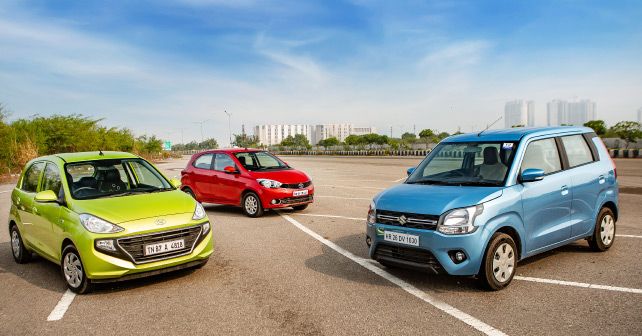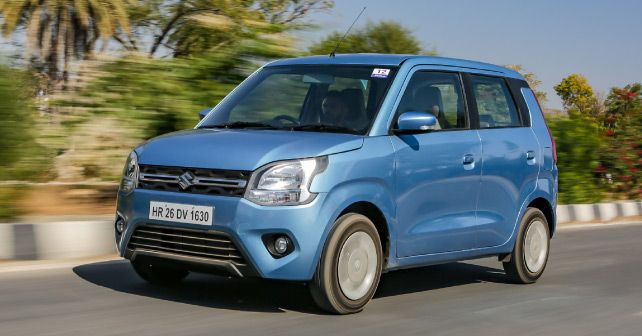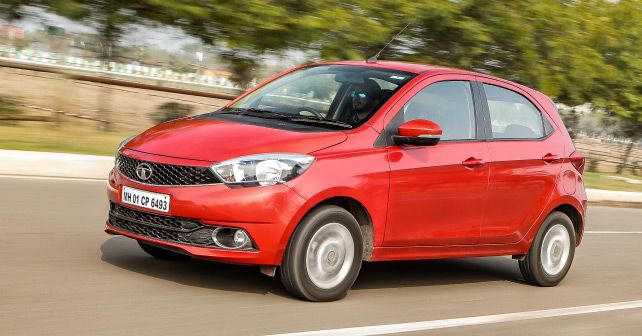AMT hatchbacks are fast gaining popularity as affordable and efficient automatic machines. Now, with a couple of new heavyweights joining the fight, it’s time to find out what the best option is for the average Joe.
I don’t know whether you remember your first time in an automatic car, but I do – it was a 2007 Honda Civic AT, and what I felt was a combination of awe, surprise and wonder. A car that shifts gears all by itself? Back then, it felt like black magic. Part of the reason was that automatic cars used to be a really expensive back in the day. And this kept the joy of two-pedal motoring out of reach of an average Joe. And so the majority of car buyers continued to manually grind gears, and their teeth, while driving through heavy traffic.
Thankfully, times have since changed – especially because of AMTs, or automated manual transmissions, have suddenly caught the fancy of mainstream carmakers. Of course, AMTs aren’t automatics in the true sense of the word, but let’s not get into technicalities. The thing to remember is that you don’t have to deal with manual gearshifts anymore. What’s more, AMTs are only getting better with time – something we’ve just witnessed in the brand new Maruti Suzuki Wagon R and the new Hyundai Santro. So, if you’re looking for an affordable automatic car, either of these will make for a good choice – or, alternatively, you could also consider the Tata Tiago AMT.
But my budget is ‘only’ Rs. 6 lakh…
If that’s the case, you don’t have to worry. The Wagon R tested here is priced at Rs. 5.69 lakh, whereas the Tiago AMT is slightly dearer, at Rs. 5.74 lakh. The Santro, however, makes for a more affordable option, at Rs. 5.46 lakh.
Which one looks the best?
If you’ve got a working pair of eyes – or even it’s only one that works – you’ll notice that none of these cars are the epitome of aesthetics. The Wagon R has always been an odd-looking car, and in its latest generation, it has become even odder. Retaining the tall-boy appearance of its predecessor, it has assumed a somewhat muscular stance. Honestly, this puffed up look doesn’t work – not for me, at least. But, then, you may like its large glass house, like some of my colleagues. Anyway, a typical Wagon R customer doesn’t care about all this. You want proof? How about this – Maruti has sold over 2.2 million units of the car since its launch in 1999!
The Santro’s approach to design has a touch of youthfulness, with balanced proportions. But you can’t help but feel that, with the new Santro, Hyundai designers have gone a bit overboard in some areas. The front-end is too busy and seems more of a reincarnation of the original i10 than the Santro Xing. The silhouette is also very similar, but this one gets multiple creases running on the front and rear fenders. Add the Dyna Green shade to the mix, and it becomes apparent that the Santro is trying quite hard to be a funky runabout.
Now, the Tiago is what I’d call a good-looking small hatchback – no odd angles, well-defined proportions, chrome detailing in all the right places and taut and muscular sheet metal. Also, it’s the only car on our list that comes with alloy wheels. So, it would be fair to say that the Tiago trumps the Wagon R and Santro in this department.

How are things inside?
Features, equipment, interior space and quality of materials – these things really matter, and that’s why manufacturers have begun to pay more attention to these aspects. Take the Wagon R for instance, in ZXi trim, it’s loaded to the gills. There’s a 7-inch touchscreen infotainment system, with a crisp and vibrant display, along with Android Auto and Apple CarPlay. Additionally, you can also connect your phone to the system via an app called SmartPlay. It’s also the only car here that comes with both electrically adjustable and foldable ORVMs.
The redesigned dual-tone dashboard, vertically stacked AC vents and the new three-spoke steering wheel bring the Wagon R in tune with the times and gives it an upmarket and airy feel. The quality of the plastics, however, remains tacky, especially the lower section of the dashboard. The HVAC controls and the housing around the gear lever are flimsy too.
In terms of practicality and cabin space, the Wagon R is unbeatable though. It has acres of space – both at the front and the back. Plus, the Wagon R has the biggest boot of the lot. However, the seats aren’t the most comfortable – they have virtually no cushioning and under-thigh support.
Step inside the Santro, and a few things become immediately apparent. The quality of switchgear and fit-and-finish of components are superior, with a more contemporary design and layout. You get a nice 7-inch touchscreen system, with Apple CarPlay and Android Auto connectivity, just like the Wagon R, but this one is more intuitive and easier to navigate through.
In terms of comfort, the Santro has the best front seats of the lot. They have an underlying firmness and offer more side support. Even the rear seats, with adequate under-thigh support, are more comfortable than those of the Wagon R. Plus, it’s the only car here with rear AC vents.
The Santro’s legroom and headroom are no match for the Wagon R though. The boot space is adequate, but again not as cavernous as that of the Wagon R. What’s more, the Santro AMT also misses out on some basic equipment – the steering wheel doesn’t even have tilt adjust, there’s no rear wiper, the doors don’t have speed-sensing locks and the most baffling omission is the lack of rear parking sensors – which are standard across the range in the Wagon R.
The Tiago, once again, takes everything up a notch in terms of interior quality and general fit-and-finish. For instance, the soft-touch material on the top of the dashboard, super comfy seats, piano black finish of the centre console, closed loop door handles, body-coloured AC vent surroundings and leather-wrapped steering wheel give the cabin a rich look and feel. But there are areas that need improvement. First of all, it doesn’t get a touchscreen infotainment in the AMT variants, instead, there’s an ancient double-DIN sound system. However, it redeems itself to an extent by being a Harman unit – the audio quality is simply the best here. The Tiago also gets an automatic rear wiper, tilt adjustable steering wheel and height adjustable driver’s seat – the only car on the list to have this. In terms of comfort and practicality, it’s not as spacious as the WagonR of course, but it does equal the Santro. However, while the seats look nice and supportive, they are soft and you tend to sink into them.
How clumsy are the gearshifts?
It’s no secret that AMTs are inherently clumsy and don’t have the smoothness of a conventional torque converter or a CVT. That said, these new gen AMT cars have really come a long way.
Let’s start with the Wagon R. It’s offered in two petrol engine options – a 1.0-litre three-cylinder and a 1.2-litre four-cylinder. Both get AMTs as an option. The one we drove had the bigger motor – dubbed the K12M – which is rated at 82bhp and 113Nm and comes paired with a 5-speed AMT. It’s a familiar combination, since it’s already available with the Swift, Ignis and Dzire. And while Maruti has definitely improved the AMT’s smoothness, the gearbox has tall ratios that ensure the transmission does not have to shift gears too often – a combination that makes the overall driving experience pleasant. Part throttle inputs in heavy traffic result in the typical AMT head-nod though. The refinement of the powertrain is impressive on the whole though.
Unlike the other two, the Santro’s AMT incorporates an electronic actuator instead of a hydraulic one to make gearshifts smoother. And it works! Whether it’s upshifts or downshifts, the transition between gears is the smoothest in the Santro. However, in heavy traffic, it’s let down by its engine. The 68bhp and 99Nm, 1.1-litre motor is peppy for the most part, but below 2,000rpm, it lacks urgency, making progress lethargic from a standstill. But once it gets going, the engine really shines. It has a strong mid-range, where it feels the most refined. It does run out of steam at higher revs, and sounds a bit gruffer than the Wagon R or Tiago.
For the Tiago, things are not very promising in this department! The Tiago’s AMT and its 1.2-litre, three-cylinder engine simply can’t compete with the likes of the Wagon R and Santro. Sure, at 84bhp and 114Nm, it’s the most powerful engine here, but that doesn’t translate well in the real world. You see, the Tiago’s AMT is indecisive at low speeds. Its inconsistent throttle response doesn’t help either. The shifts are slow and jerky, which makes driving the car quite excruciating. At times, it goes into hibernation and refuses to drop cogs – for instance, during a quick overtake.
Also, the Tiago’s three-cylinder unit isn’t the most refined, particularly at idle. Once you’re out on the open road though, the engine shows its true free-revving nature. However, you don’t buy an AMT car for its performance on open roads, or do you?
What about ride and handling?
None of these cars are aimed to awake the boy-racer in you, which means they’re all tuned for comfort. And, in this regard, the Wagon R excels. The ride quality is stellar, and it tackles all undulations confidently. The credit here must go to the new Heartect platform, which is the same that underpins the Swift, Baleno and Ignis. The handling is pretty predictable too. Sure, there’s a lot of body-roll in the corners, but the front end tucks in nicely. The steering, however, has little in terms of feel and is relatively heavy at low speeds.
The Santro’s suspension is decidedly firmer, but the ride quality doesn’t suffer and it feels compliant. And because it’s more compact, driving the Santro in congested areas is easier and more fun. The steering has some amount of feel, but it doesn’t weigh up enough at high speeds. The Tiago wins some points back in the ride-and-handling department, owing to the perfect balance of its setup. It feels confident and planted around corners, but this doesn’t come at the expense of the ride quality. In fact, it rides like a bigger car.
Which one would you crash?
In terms of safety, they all come with some basic equipment. ABS with EBD and driver airbags are standard fitment in all three, but only the Wagon R and Tiago get front passenger airbags. In fact, a passenger airbag is optional on both these cars across all of their variants.
Which one then?
Personally, I was rooting for the Tiago, since it looks the best. Its ride-and-handling balance is spot-on, and it’s decently equipped with sturdy build quality. However, its AMT drivetrain was a big let-down, which means that it had to be ruled out straight away.
Now, this is where it gets tricky, because it’s tough to pick a winner between the Wagon R and Santro. The Santro is more fun to drive. Its AMT is easy to live with, and its seats are more comfortable. Also, the quality of components is superior. However, the AMT isn’t available in top-spec trim, meaning that some pieces of equipment are missing. The Wagon R, on the other hand, has virtually everything covered. The engine and gearbox combo works well. It’s unbelievably spacious, and the AMT version is available in all but the base variant. Its only questionable aspect is the oddball design. But, if you can look past its boxy and unimaginative look, I must conclude that it’s the most complete AMT car of the three that we have here.
In terms of practicality and cabin space, the Wagon R is unbeatable. It has acres of space, as well as the biggest boot of the lot.
Unlike the other two, the Santro’s AMT incorporates an electronic actuator instead of a hydraulic one to make gearshifts smoother. And it works! Whether it’s upshifts or downshifts, the transition between gears is the smoothest in the Santro.
The cabin of the Tiago has good fit-and-finish. The soft-touch material on the top of the dashboard, super comfy seats, piano black finish of the centre console, closed loop door handles, body-coloured AC vents and leather-wrapped steering wheel give the cabin a rich look and feel.
- Maruti Suzuki Wagon R 1.2 AGS
- Hyundai Santro AMT
- Tata Tiago XZA
Engine: 1,197cc / 4-Cylinders / 16-Valves
Fuel: Petrol
Transmission: 5-Speed AMT / Front-Wheel Drive
Power:82bhp @ 6,000rpm
Torque:113Nm @ 4,200rpm
Price: Rs.5.69 lakh (Ex-showroom, Delhi)
X-factor: Bigger engine, more space, more equipment and an effortless driving experience ensure that the Wagon R AMT will fly off the shelves.
| Pros • Well-calibrated AMT • Space • Equipment | Cons • Oddball design • Wafer-thin seats |
Engine: 1,086cc / 4-Cylinders / 12-Valves
Fuel: Petrol
Transmission: 5-Speed AMT / Front-Wheel Drive
Power: 68bhp @ 5,500rpm
Torque: 99Nm @ 4,500rpm
Price: Rs.5.47 lakh(Ex-showroom Delhi)
X-factor: Most refined and smooth AMT drivetrain make the Santro an impeccable daily runabout.
| Pros • Quality interiors • Peppy performance • Smooth powertrain | Cons • AMT not available in top-spec • No parking sensors |
Engine: 1,199cc / In-line 3-Cylinders / 12 valves
Fuel: Petrol
Power: 83bhp @ 6,000rpm
Torque: 114Nm @ 3,500rpm
Transmission: 5-Speed Manual / Front-Wheel Drive
Price: Rs.5.74 lakh (Ex-showroom, Delhi)
X-factor: With mature driving dynamics, a spacious interior and good looks, the Tiago will definitely find some takers.
| Pros • Ride & handling balance • Good looking | Cons • Slow & unrefined AMT • Misses out on some features |
































Write your Comment